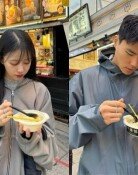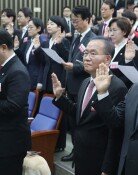K-Pop success for easy choreography
Psys new song Gentleman is spreading in a similar way that the Korean rappers Gangnam Style swept the globe last year. Many parody videos and video footages showing the reactions of netizens are being uploaded online. One of the K-Pops characteristics to have greatly contributed to the success is the so-called point choreography, key movements that capture peoples attention in a song.
In the parody videos of Gentleman, the focus is also on the point choreography or key movements, dubbed as a cheeky dance: Psy repeatedly shakes his hip between right and left while cynically looking at cameras. The cheeky dance was introduced by Brown-eyed Girls, a Korean girls idol group, in 2009 and made a big hit. Point choreography is used for the chorus part of a song by idol groups so that each group can appeal its music more effectively to music fans. Psys horse riding dance and cheeky dance can be said the most successful cases of the point choreography of K-Pop.
Key movements in a song have almost become a stereotype of K-Pops as shown in the success of the key movements in Tell Me and Nobody of Wonder Girls, Sorry Sorry by Super Junior, Bopip Bopip of Tiara, Hoot of Girls Generation and many others. K-Pops key movements have helped shape bodylines of people around the world. The origin of K-Pops key choreography goes back to the national gymnastics that all the students in Korea learned from elementary school. The national gymnastics is composed of easy movements that anyone can follow, including those of stretching arms and legs or jumping lightly.
Nevertheless, easy-to-follow key movements alone do not make the song popular. The movements must match and highlight the characteristics of the lyrics and rhythm of the song. Creating key movements that satisfy the both conditions is no easy. There are two kinds of K-pop choreographers: one who creates cool movements for the music, the other who makes key movements to create popularity. I had to pay a considerable amount of money to a choreography team renowned for point dance, said the president of a small entertainment company who planned the new girl group`s debut last year.
The price of choreography is determined according to the choreographer, not the singer. Choreographers who make a rough design for a song receive between 3 million won (2,682 U.S. dollars) and 5 million won (4,470 dollars), while famous choreographers can receive up to 10 million won (8,940 dollars). The payment for a dance is made at once but no royalty is paid afterwards since the copyright system for dance movement has not established yet. On the other hand, lyrics and composition are protected by copyrights and fees are paid to those who made them whenever songs are consumed.
Considering the popularity of the choreography of K-Pops, the choreographers are not treated appropriately. Though many foreign singers and entertainment companies want to get dance movements from Korean choreographers, they simply cannot because no mediator or individual is available to help them. A dance team member said, Though many foreign music companies want to place orders for choreography with Korean choreographers, they cant reach the dance team they want. Korean choreographers have great capabilities, but they dont receive the treatment they deserve.
imi@donga.com







